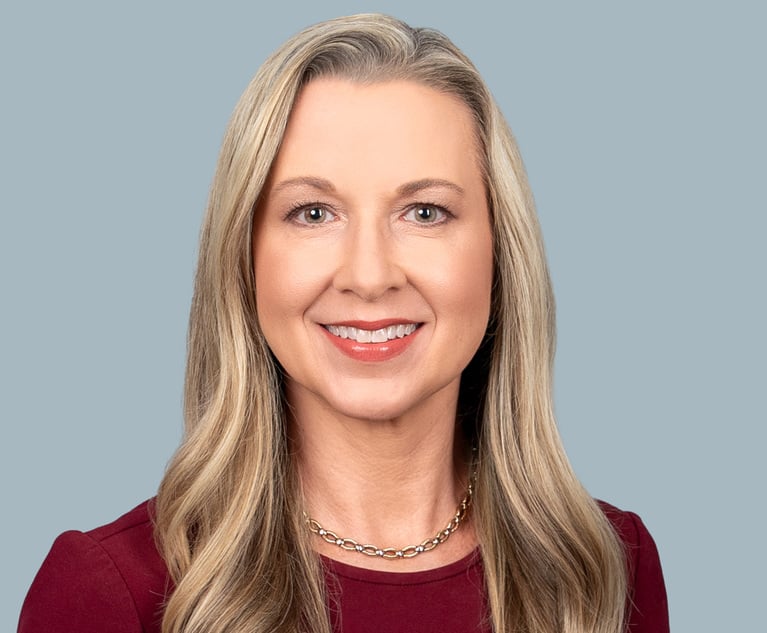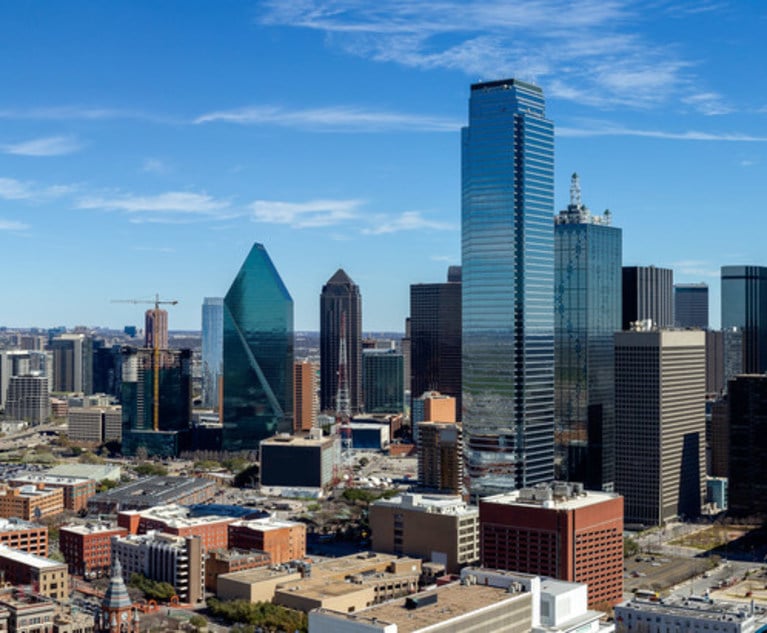 Wally Martinez, John Hern and Jay Rothman. Courtesy photos.
Wally Martinez, John Hern and Jay Rothman. Courtesy photos.After a Year, Leaders of Merged Texas Firms Reflect on Combinations
A year after three large Texas firms merged with national firms, their leaders are optimistic about the future.
April 29, 2019 at 04:21 PM
7 minute read
For the three big Texas firms that merged with national firms last year, the honeymoon is over. But the leaders of the those combined firms said the effort to join together was well worth it, as they look forward to even greater gains.
In interviews earlier this year, the firm leaders pointed to strong financial results for 2018 and tangible benefits of cross-selling and collaboration. Looking ahead, they said they expect to build on that growth as they wrap up the first year of integration, which is necessary but financially costly and time-intensive.
“The mood around the firm is really, really upbeat. The opportunity for our firm has never been stronger in our 129-year history,” said John Hern Jr., chief executive officer of Clark Hill, the Detroit firm that merged with Dallas-based Strasburger & Price. The firm is known as Clark Hill Strasburger in Texas.
Also in April 2018, Andrews Kurth Kenyon of Houston merged with Virginia firm Hunton & Williams, creating Hunton Andrews Kurth, and Gardere Wynne Sewell of Dallas merged with Foley & Lardner of Milwaukee. That firm is known as Foley & Lardner, except in Texas, where it is Foley Gardere, and Foley Gardere Arena in Mexico.
The Texas mergers were three of the five largest law firm combinations in 2018, according to Altman Weil's MergerLine.
All three firms showed obvious growth in revenue, even if profitability lagged slightly for some of them.
At Clark Hill, gross revenue grew by 52.8% to $295.9 million, and net income increased by 71.8% to $65.8 million. Revenue per lawyer also improved, up 5.4% from 2017 to $506,000. Profits per equity partner slipped by 1.3%, coming in at $518,000, as the firm's equity partner count grew by 74%, to 127 in 2018, up from 73 in 2017.
Hern said lawyers from both firms devoted a lot of time and energy to the merger and integration.
Gross revenue and net income also grew in a big way at Foley & Lardner. Revenue came in at $836.7 million, up 21.9% from 2017, and net income was up 15.5% at $195.3 million. Even with a major head count boost, RPL was $858,000, up 2.9%, and PEP was $1.25 million, up 7.2% from 2017.
“We were delighted in the growth this year, particularly with all of the expenses associated with the consolidation and, frankly, the effort,” Jay Rothman, chairman and chief executive officer of Foley & Lardner, told Texas Lawyer in an interview earlier this month.
There is no 2017 to 2018 financial comparison available for Hunton Andrews, because the combined firm—with a new name—formed on April 2, 2018. But the firm posted $748 million in revenue in its first fiscal year, which ended on March 31, 2019, which was right in line with what firm leaders expected when the firms merged a year ago.
RPL per lawyer was $861,000 at Hunton Andrews, relatively close to legacy firm Hunton & Williams' 2017 RPL of $859,000, but short of Andrews Kurth's $931,000 for 2017. PEP came in at nearly $1.1 million in 2018, which was very close to Hunton & Williams' figure in 2017, but less than Andrews Kurth's PEP of $1.2 million.
“The first six months were of unbelievable change, unbelievable stress, unbelievable time disruption, but the last six months, you've really seen the thing come together as one law firm. Practitioners have discovered each other,” Wally Martinez, managing partner of Hunton Andrews, told Texas Lawyer in an interview earlier this year.
|The Costs
Consolidation did cause disruption and cost money for each of the combined firms, cutting into the gains reaped from the mergers.
Rothman estimates Foley & Lardner spent $8 million to $10 million in technology and getting lawyers and employees of the firm together.
Martinez said one-time expenses related to Hunton Andrews' merger totaled about $9 million. That included the costs of consolidating lawyers in cities where both legacy firms had existing offices, integrating technology and phone systems, and eliminating debt that Andrews Kurth had incurred in its 2016 acquisition of about 55 lawyers from New York intellectual property firm Kenyon & Kenyon.
Hern said the out-of-pocket costs at Clark Hill totaled several million dollars, including consultants and the expense of merging tech platforms.
“There's also a human cost that everyone needs to take into account. Our people, and they are wonderful people, had their day job and had the integration work on top of it,” he said.
To accelerate the integration, Hern said the firm started with a retreat with all partners in Dallas last July, including partners from the firm's Ireland office. Next was a “road show,” where firm leaders went to each office and made the same presentation about core values and the importance of client service. Then, leadership of the 17 business units worked on integration through numerous meet-and-greets, while at the same time the executive leadership team met together at various offices.
The mergers have been successful in several ways, according to assessments from the firm leaders.
|New Opportunities
Hern said the strategy for the merger between Clark Hill and Strasburger & Price was to provide more value for clients by creating a broader geographic reach. The firm now has 25 offices.
That client-centric goal has been realized, Hern said. For example, he said, in a recent admiralty matter that originated in San Diego, lawyers on the other side moved the litigation to Texas. Clark Hill was able to keep the work because of the Texas offices. Similarly, Hern said, a Texas client had an environmental matter in California, which Clark Hill was able to handle post-merger.
Hern said the firm got millions of dollars of business from clients it would not have brought in without the merger.
That's also the case at Hunton Andrews, according to Martinez, who noted that legacy Hunton & Williams cybersecurity lawyers have been able to cross-sell to the large group of oil and gas clients of legacy Andrews Kurth. Also, the capital markets and tax practices are working closely together, he said.
Hunton Andrews wasn't able to combine financial systems until November, according to Martinez, which allowed the firm to more easily track matters in which lawyers from both legacy firms were involved. They tracked more than 500 joint matters during that time, he said.
The same benefit is also evident at Foley & Lardner, where Rothman said in the interview that between the April 2018 merger and the end of the fiscal year on Jan. 31, the firm opened about 125 new matters which accounted for about 15,000 billable hours. He said the firm's lawyers, through cross-selling the cooperation, added at least $10 million in work they would not have received without the merger.
All three of the firms have also been active in the lateral hiring market since the combinations.
Clark Hill's hires in 2018 include cybersecurity partner Melissa Ventrone in Chicago; transportation litigation partner Bradford Hughes in Los Angeles; and Chicago senior counsel Latasha Thomas in the government and public affairs practice.
Hunton Andrews added a number of laterals, such as energy regulatory partners Myles Reynolds and Tab Urbantke in Dallas; financial institutions corporate and regulatory partner Erin Fonte in Austin; and finance special counsel Michael Zinder in New York.
Among Foley & Lardner's post-merger hires were Craig Chick, a director of public affairs in the government solutions practice in Austin; and counsel Neal Bakare, an energy and finance lawyer in Houston.
“We view this as evolutionary. It is iterative. We will never be done,” Rothman, of Foley & Lardner, said.
|Read More
This content has been archived. It is available through our partners, LexisNexis® and Bloomberg Law.
To view this content, please continue to their sites.
Not a Lexis Subscriber?
Subscribe Now
Not a Bloomberg Law Subscriber?
Subscribe Now
NOT FOR REPRINT
© 2025 ALM Global, LLC, All Rights Reserved. Request academic re-use from www.copyright.com. All other uses, submit a request to [email protected]. For more information visit Asset & Logo Licensing.
You Might Like
View All

Legal Malpractice: Texas Supreme Court OKs 'Pernicious Distortion of Positions'
4 minute read
Ex-Six Flags CLO Lands New C-Suite Post—This Time as HR Chief

Trending Stories
- 1Decision of the Day: Uber Cannot Be Held Vicariously Liable for Driver's Alleged Negligent Conduct
- 2TikTok Law and TikTok Politics
- 3California Supreme Court Vacates Murder Conviction in Infant Abuse Case
- 4New York’s Proposed Legislation Restraining Transfer of Real Property
- 5Withers Hires Lawyers, Staff From LA Trusts and Estates Boutique
Who Got The Work
Michael G. Bongiorno, Andrew Scott Dulberg and Elizabeth E. Driscoll from Wilmer Cutler Pickering Hale and Dorr have stepped in to represent Symbotic Inc., an A.I.-enabled technology platform that focuses on increasing supply chain efficiency, and other defendants in a pending shareholder derivative lawsuit. The case, filed Oct. 2 in Massachusetts District Court by the Brown Law Firm on behalf of Stephen Austen, accuses certain officers and directors of misleading investors in regard to Symbotic's potential for margin growth by failing to disclose that the company was not equipped to timely deploy its systems or manage expenses through project delays. The case, assigned to U.S. District Judge Nathaniel M. Gorton, is 1:24-cv-12522, Austen v. Cohen et al.
Who Got The Work
Edmund Polubinski and Marie Killmond of Davis Polk & Wardwell have entered appearances for data platform software development company MongoDB and other defendants in a pending shareholder derivative lawsuit. The action, filed Oct. 7 in New York Southern District Court by the Brown Law Firm, accuses the company's directors and/or officers of falsely expressing confidence in the company’s restructuring of its sales incentive plan and downplaying the severity of decreases in its upfront commitments. The case is 1:24-cv-07594, Roy v. Ittycheria et al.
Who Got The Work
Amy O. Bruchs and Kurt F. Ellison of Michael Best & Friedrich have entered appearances for Epic Systems Corp. in a pending employment discrimination lawsuit. The suit was filed Sept. 7 in Wisconsin Western District Court by Levine Eisberner LLC and Siri & Glimstad on behalf of a project manager who claims that he was wrongfully terminated after applying for a religious exemption to the defendant's COVID-19 vaccine mandate. The case, assigned to U.S. Magistrate Judge Anita Marie Boor, is 3:24-cv-00630, Secker, Nathan v. Epic Systems Corporation.
Who Got The Work
David X. Sullivan, Thomas J. Finn and Gregory A. Hall from McCarter & English have entered appearances for Sunrun Installation Services in a pending civil rights lawsuit. The complaint was filed Sept. 4 in Connecticut District Court by attorney Robert M. Berke on behalf of former employee George Edward Steins, who was arrested and charged with employing an unregistered home improvement salesperson. The complaint alleges that had Sunrun informed the Connecticut Department of Consumer Protection that the plaintiff's employment had ended in 2017 and that he no longer held Sunrun's home improvement contractor license, he would not have been hit with charges, which were dismissed in May 2024. The case, assigned to U.S. District Judge Jeffrey A. Meyer, is 3:24-cv-01423, Steins v. Sunrun, Inc. et al.
Who Got The Work
Greenberg Traurig shareholder Joshua L. Raskin has entered an appearance for boohoo.com UK Ltd. in a pending patent infringement lawsuit. The suit, filed Sept. 3 in Texas Eastern District Court by Rozier Hardt McDonough on behalf of Alto Dynamics, asserts five patents related to an online shopping platform. The case, assigned to U.S. District Judge Rodney Gilstrap, is 2:24-cv-00719, Alto Dynamics, LLC v. boohoo.com UK Limited.
Featured Firms
Law Offices of Gary Martin Hays & Associates, P.C.
(470) 294-1674
Law Offices of Mark E. Salomone
(857) 444-6468
Smith & Hassler
(713) 739-1250






